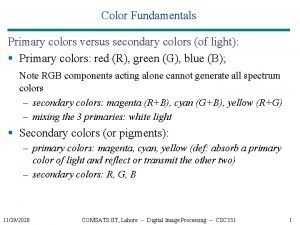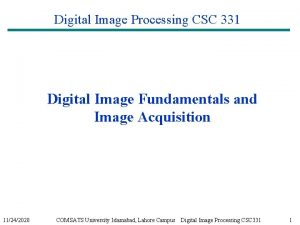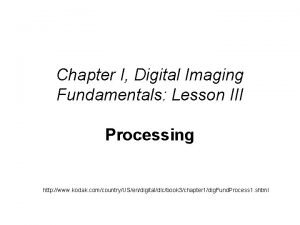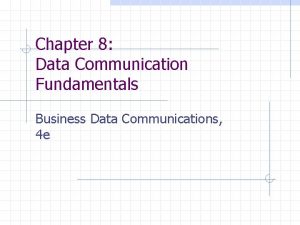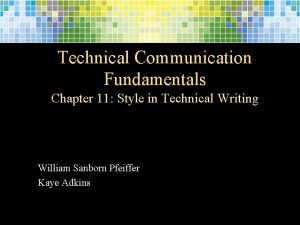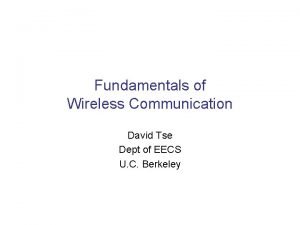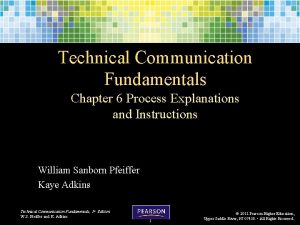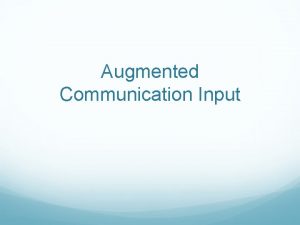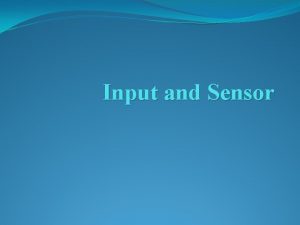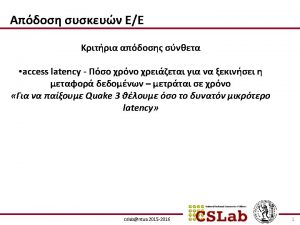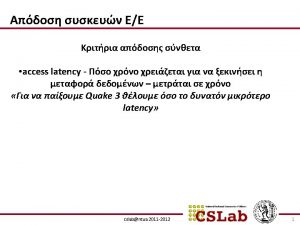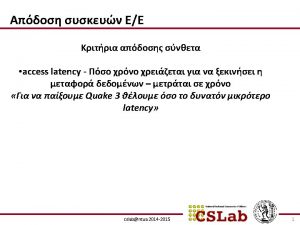Fundamentals of Digital Communication Digital communication system Input






![Shannon limit … C/W [bits/s/Hz] Unattainable region Practical region SNR [d. B] 7 Shannon limit … C/W [bits/s/Hz] Unattainable region Practical region SNR [d. B] 7](https://slidetodoc.com/presentation_image_h/cc493c7d7904a153bf9d09040dc7e9df/image-7.jpg)

![Shannon limit … Practical region W/C [Hz/bits/s] Unattainable region -1. 6 [d. B] 9 Shannon limit … Practical region W/C [Hz/bits/s] Unattainable region -1. 6 [d. B] 9](https://slidetodoc.com/presentation_image_h/cc493c7d7904a153bf9d09040dc7e9df/image-9.jpg)
![Bandwidth efficiency plane R>C Unattainable region M=256 M=64 R=C R/W [bits/s/Hz] M=16 M=8 M=4 Bandwidth efficiency plane R>C Unattainable region M=256 M=64 R=C R/W [bits/s/Hz] M=16 M=8 M=4](https://slidetodoc.com/presentation_image_h/cc493c7d7904a153bf9d09040dc7e9df/image-10.jpg)






- Slides: 16

Fundamentals of Digital Communication

Digital communication system Input Signal Analog/ Digital Low Pass Filter Sampler Quantizer Source Encoder Channel Encoder Multiplexer Carrier To Channel Modulator Pulse Shaping Filters From Channel De. Modulator Receiver Filter Line Encoder Detector Carrier Ref. Signal at the user end Digital-to-Analog Converter Channel Decoder De. Multiplexer 2

Noiseless Channels and Nyquist Theorem For a noiseless channel, Nyquist theorem gives the relationship between the channel bandwidth and maximum data rate that can be transmitted over this channel. Nyquist Theorem C: channel capacity (bps) B: RF bandwidth m: number of finite states in a symbol of transmitted signal Example: A noiseless channel with 3 k. Hz bandwidth can only transmit a maximum of 6 Kbps if the symbols are binary symbols. 3

Nyquist minimum bandwidth requirement n The theoretical minimum bandwidth needed for baseband transmission of Rs symbols per second is Rs/2 hertz ? 4

Shannon’s Bound for noisy channels There is a fundamental upper bound on achievable bandwidth efficiency. Shannon’s theorem gives the relationship between the channel bandwidth and the maximum data rate that can be transmitted over a noisy channel. Shannon’s Theorem C: channel capacity (maximum data-rate) (bps) B or W : RF bandwidth S/N: signal-to-noise ratio (no unit) 5

Shannon limit … n Shannon theorem puts a limit on transmission data rate, not on error probability: n n Theoretically possible to transmit information at any rate Rb , where Rb C with an arbitrary small error probability by using a sufficiently complicated coding scheme. For an information rate Rb > C , it is not possible to find a code that can achieve an arbitrary small error probability. 6
![Shannon limit CW bitssHz Unattainable region Practical region SNR d B 7 Shannon limit … C/W [bits/s/Hz] Unattainable region Practical region SNR [d. B] 7](https://slidetodoc.com/presentation_image_h/cc493c7d7904a153bf9d09040dc7e9df/image-7.jpg)
Shannon limit … C/W [bits/s/Hz] Unattainable region Practical region SNR [d. B] 7

Shannon limit … Shannon limit n n There exists a limiting value of below which there can be no error-free communication at any information rate. By increasing the bandwidth alone, the capacity cannot be increased to any desired value. 8
![Shannon limit Practical region WC Hzbitss Unattainable region 1 6 d B 9 Shannon limit … Practical region W/C [Hz/bits/s] Unattainable region -1. 6 [d. B] 9](https://slidetodoc.com/presentation_image_h/cc493c7d7904a153bf9d09040dc7e9df/image-9.jpg)
Shannon limit … Practical region W/C [Hz/bits/s] Unattainable region -1. 6 [d. B] 9
![Bandwidth efficiency plane RC Unattainable region M256 M64 RC RW bitssHz M16 M8 M4 Bandwidth efficiency plane R>C Unattainable region M=256 M=64 R=C R/W [bits/s/Hz] M=16 M=8 M=4](https://slidetodoc.com/presentation_image_h/cc493c7d7904a153bf9d09040dc7e9df/image-10.jpg)
Bandwidth efficiency plane R>C Unattainable region M=256 M=64 R=C R/W [bits/s/Hz] M=16 M=8 M=4 Bandwidth limited M=2 M=4 M=2 M=8 R<C Practical region M=16 Shannon limit Power limited MPSK MQAM MFSK 10

Error probability plane (example for coherent MPSK and MFSK) M-PSK bandwidth-efficient M-FSK power-efficient k=5 Bit error probability k=4 k=1 k=2 k=4 k=3 k=5 k=1, 2 11

M-ary signaling n Bandwidth efficiency: n n n Assuming Nyquist (ideal rectangular) filtering at baseband, the required passbandwidth is: M-PSK and M-QAM (bandwidth-limited systems) n Bandwidth efficiency increases as M increases. MFSK (power-limited systems) n Bandwidth efficiency decreases as M increases. 12

Power and bandwidth limited systems n n Two major communication resources: n Transmit power and channel bandwidth In many communication systems, one of these resources is more precious than the other. Hence, systems can be classified as: n n Power-limited systems: n save power at the expense of bandwidth (for example by using coding schemes) Bandwidth-limited systems: n save bandwidth at the expense of power (for example by using spectrally efficient modulation schemes) 13

Goals in designing a DCS n Goals: n n n Maximizing the transmission bit rate Minimizing probability of bit error Minimizing the required power Minimizing required system bandwidth Maximizing system utilization Minimize system complexity 14

Limitations in designing a DCS n n n The Nyquist theoretical minimum bandwidth requirement The Shannon-Hartley capacity theorem (and the Shannon limit) Government regulations Technological limitations Other system requirements (e. g satellite orbits) 15

16
 Output
Output Berikut ini adalah salah satu jenis peripheral input adalah
Berikut ini adalah salah satu jenis peripheral input adalah Finely tuned input and roughly tuned input
Finely tuned input and roughly tuned input Digital fundamentals chapter 4
Digital fundamentals chapter 4 Digital fundamentals floyd ppt
Digital fundamentals floyd ppt Digital fundamentals 10th edition
Digital fundamentals 10th edition Color fundamentals in digital image processing
Color fundamentals in digital image processing Floyd digital fundamentals ppt
Floyd digital fundamentals ppt Digital fundamentals answers
Digital fundamentals answers Digital image fundamentals
Digital image fundamentals Fundamentals of digital imaging
Fundamentals of digital imaging Fundamentals of data communication
Fundamentals of data communication Style of technical communication
Style of technical communication David tse fundamentals of wireless communication
David tse fundamentals of wireless communication Fundamentals of organizational communication
Fundamentals of organizational communication Fundamentals of organizational communication 9th edition
Fundamentals of organizational communication 9th edition Technical communication fundamentals
Technical communication fundamentals






